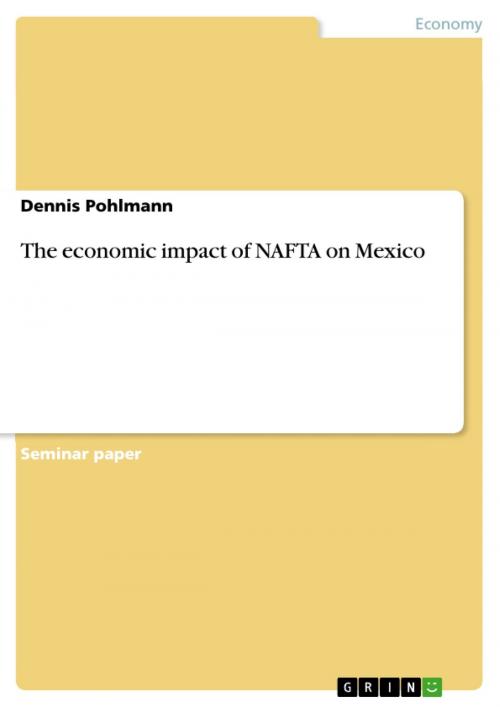| Author: | Dennis Pohlmann | ISBN: | 9783638586238 |
| Publisher: | GRIN Publishing | Publication: | January 26, 2007 |
| Imprint: | GRIN Publishing | Language: | English |
| Author: | Dennis Pohlmann |
| ISBN: | 9783638586238 |
| Publisher: | GRIN Publishing |
| Publication: | January 26, 2007 |
| Imprint: | GRIN Publishing |
| Language: | English |
Seminar paper from the year 2006 in the subject Economics - International Economic Relations, grade: 1,0, Drury University (Breech School of Business Administration), course: International Economics, 19 entries in the bibliography, language: English, abstract: Many countries are reducing trade barriers and promoting regional economic integration. A result of this is the rising of free-trade areas in which the belonging countries trade freely among themselves without tariffs or trade restrictions. One example for a free-trade area is the North American Free Trade Agreement (NAFTA) founded by the U.S., Mexico and Canada. When NAFTA took effect on January 1, 1994, it created the world´s largest free-trade zone with a combined population of over 416 million and a total GDP of $12 trillion. Of course, the U.S., as the world´s largest single market, dominates the North American business environment. The goal of NAFTA is to eliminate all the trade barriers between the three countries over a 15-year period, completed in 2009. NAFTA also substantially reduces, but does not completely eliminate, nontariff trade barriers like import quotas, sanitary regulations, and licensing agreements. From the beginning, NAFTA had a lot of opponents in the U.S. as well as in Mexico. For example, U.S. labor unions feared a loss in jobs because of dislocating production from the USA to Mexico by reason of lower wages. In Mexico, farmers opposed and still opposing NAFTA because of the high U.S. subsidies on agricultural products that are imported to Mexico. There were also beliefs from environmental, social justice, and other advocacy organizations stating that NAFTA has unfavorable impacts on non-economic areas like public health or environment. On the other hand, Mexican proponents supporting NAFTA argued that open trade could reduce migration from Mexico into the U.S. in the long run since NAFTA brings an improvement of the Mexican economy relative to the U.S. economy (Acevedo & Espenshade, 1992, p. 742). Between 1994 and 2003 Mexico´s average annual GDP growth was 2.7 percent (Hufbauer & Schott, p. 2). At the first sight, NAFTA seems to be a benefit for the Mexican economy at the whole. Nevertheless, there are gainers and losers as a result of free trade. The content of this paper is to have a closer look on the Mexican economy and to answer the following three questions: 1. Can the trade pattern between Mexico and the U.S. be determined by using economic models? 2. Can the winners and losers that are resulting from the trade pattern between the U.S. and Mexico be explained with these models? 3. According to the economic models of international trade, does Mexico benefit like predicted?
Seminar paper from the year 2006 in the subject Economics - International Economic Relations, grade: 1,0, Drury University (Breech School of Business Administration), course: International Economics, 19 entries in the bibliography, language: English, abstract: Many countries are reducing trade barriers and promoting regional economic integration. A result of this is the rising of free-trade areas in which the belonging countries trade freely among themselves without tariffs or trade restrictions. One example for a free-trade area is the North American Free Trade Agreement (NAFTA) founded by the U.S., Mexico and Canada. When NAFTA took effect on January 1, 1994, it created the world´s largest free-trade zone with a combined population of over 416 million and a total GDP of $12 trillion. Of course, the U.S., as the world´s largest single market, dominates the North American business environment. The goal of NAFTA is to eliminate all the trade barriers between the three countries over a 15-year period, completed in 2009. NAFTA also substantially reduces, but does not completely eliminate, nontariff trade barriers like import quotas, sanitary regulations, and licensing agreements. From the beginning, NAFTA had a lot of opponents in the U.S. as well as in Mexico. For example, U.S. labor unions feared a loss in jobs because of dislocating production from the USA to Mexico by reason of lower wages. In Mexico, farmers opposed and still opposing NAFTA because of the high U.S. subsidies on agricultural products that are imported to Mexico. There were also beliefs from environmental, social justice, and other advocacy organizations stating that NAFTA has unfavorable impacts on non-economic areas like public health or environment. On the other hand, Mexican proponents supporting NAFTA argued that open trade could reduce migration from Mexico into the U.S. in the long run since NAFTA brings an improvement of the Mexican economy relative to the U.S. economy (Acevedo & Espenshade, 1992, p. 742). Between 1994 and 2003 Mexico´s average annual GDP growth was 2.7 percent (Hufbauer & Schott, p. 2). At the first sight, NAFTA seems to be a benefit for the Mexican economy at the whole. Nevertheless, there are gainers and losers as a result of free trade. The content of this paper is to have a closer look on the Mexican economy and to answer the following three questions: 1. Can the trade pattern between Mexico and the U.S. be determined by using economic models? 2. Can the winners and losers that are resulting from the trade pattern between the U.S. and Mexico be explained with these models? 3. According to the economic models of international trade, does Mexico benefit like predicted?















